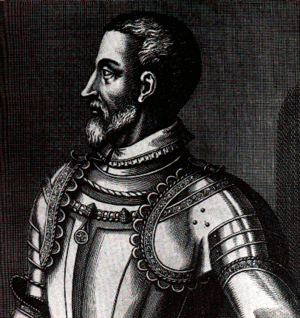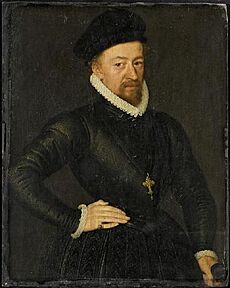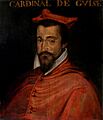Francis, Duke of Guise facts for kids
Quick facts for kids
Francis
|
|
|---|---|
| Duke of Guise Duke of Aumale Prince de Joinville |
|
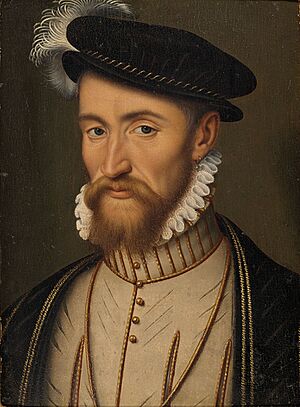
Portrait by Workshop of François Clouet
|
|
| Duke of Guise | |
| Reign | 12 April 1550 – 24 February 1563 |
| Predecessor | Claude |
| Successor | Henry I |
| Born | 17 February 1519 Bar-le-Duc, Lorraine, Holy Roman Empire |
| Died | 24 February 1563 (aged 44) near Orléans, France |
| Noble family | Guise |
| Spouse(s) | |
| Issue | Henry I, Duke of Guise Catherine Charles, Duke of Mayenne Louis II, Cardinal of Guise François |
| Father | Claude, Duke of Guise |
| Mother | Antoinette de Bourbon |
Francis I of Lorraine (born February 17, 1519 – died February 24, 1563) was an important French general and leader. He was also known as the 2nd Duke of Guise, the 1st Prince of Joinville, and the 1st Duke of Aumale. Francis played a big role in the Italian War of 1551–1559 and the French Wars of Religion. He was sadly killed during a battle near Orléans in 1563.
Contents
Early Life and Family
Francis was born in Bar-le-Duc, a region called Lorraine. His father was Claude, Duke of Guise, who became the Duke of Guise in 1527. His mother was Antoinette de Bourbon. Francis had a famous sister, Mary of Guise, who married James V of Scotland and was the mother of Mary, Queen of Scots. His younger brother was Charles, Cardinal of Lorraine. Francis grew up with his cousin, Henry II of France, and was a very important person in France because of his family.
A Famous Scar
In 1545, Francis was badly hurt during a battle called the Second Siege of Boulogne. A lance hit him through his helmet, piercing both his cheeks. Even with such a serious injury, he stayed on his horse and rode back to his tent. When the doctor pulled out the broken piece of the lance, Francis acted as if it was just pulling a hair. This brave act and the scar it left earned him the nickname "Le Balafré", which means "The Scarred One".
In 1548, Francis married Anna d'Este. She was the daughter of the Duke of Ferrara, Ercole II d'Este, and a French princess named Renée.
Military Achievements
Francis was a skilled military leader. In 1551, he became the Grand Chamberlain of France, a very important position in the king's household.
Defending Metz
He became famous around the world in 1552 when he successfully defended the city of Metz. He stopped the powerful army of Charles V, Holy Roman Emperor, from taking the city. He also defeated the emperor's troops again at the Battle of Renty in 1554.
Campaigns in Italy and France
In 1557, Francis led a French army into Italy to help Pope Paul IV. His army captured a city called Valenza. Later, he was asked to go to Naples, but his soldiers were unhappy because they weren't getting paid. He then had to quickly return to France because the French army had suffered a big defeat at the Battle of St. Quentin.
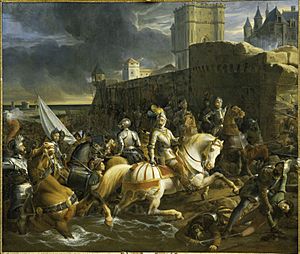
When he returned, Francis was made Lieutenant-General, a top military commander. He then led his troops to capture Calais from the English on January 7, 1558. This was a huge victory for France! He also captured Thionville and Arlon that summer. Francis was preparing to attack Luxembourg when a peace treaty, the Peace of Cateau-Cambrésis, was signed. During the reign of King Henry II, Francis was one of France's most important military figures. People liked him because he was polite and honest.
Rise to Power
When Francis's niece, Mary, Queen of Scots, became queen of France with her husband, Francis II of France, it was a great time for the Guise family. Francis and his brother, Charles, Cardinal of Lorraine, became the most powerful people in the king's council.
The French Wars of Religion
The Guise family was very Catholic, and their power worried the Protestants, also known as Huguenots. A Protestant gentleman named La Renaudie planned a secret plot, called the conspiracy of Amboise, to capture Francis and his brother. However, the plot was discovered early. On March 12, 1560, the Huguenots attacked the Château d'Amboise, where the young king and queen were staying. The uprising was quickly stopped, and many people were punished.
Changes in Power
After this event, the Guises became even more powerful. However, King Francis II died on December 5, 1560. This meant Mary, Queen of Scots, lost her power, and the Guise family's influence also decreased. Francis then lived quietly on his family's lands.
The new regent, Catherine de' Medici, at first wanted to be fair to the Protestants. To protect the Catholic faith, Francis joined with other powerful leaders to form a group called the "triumvirate." They were against Catherine's plans to make peace with the Protestants.
The Massacre of Vassy
On March 1, 1562, as Francis was traveling through a town called Wassy-sur-Blaise, a terrible event happened. Many Protestants were killed in what became known as the Massacre of Vassy. It's not fully known how much Francis was responsible, but this event started open fighting in the French Wars of Religion.
Francis then led Catholic forces in several battles. He recaptured Rouen from the Protestants and won the Battle of Dreux in December. In this battle, the Protestant leader, Condé, was captured.
Assassination
Francis was about to capture the city of Orléans from the Huguenots when he was wounded on February 18, 1563. A Huguenot assassin named Jean de Poltrot de Méré shot him. Francis died six days later from his injuries.
This was not the first time someone tried to kill him. There had been a plot to kill him during a hunting trip in 1560, but it was discovered.
Francis's death stopped the fighting for a short time. The assassin, Poltrot, at first said that Coligny, a Protestant leader, was involved. Even though Poltrot later changed his story and Coligny said he wasn't responsible, a bitter fight started between Francis's son, Henry, and Coligny. This feud eventually led to the terrible St Bartholomew's Day massacre years later.
Family
Francis and Anna d'Este were married on April 29, 1548. They had seven children:
- Henry I, Duke of Guise (1550–1588), who became the next Duke of Guise.
- Catherine (1551–1596).
- Charles, Duke of Mayenne (1554–1611).
- Louis II, Cardinal of Guise (1555–1588), who became an Archbishop.
- Antoine (1557–1560).
- François (1559–1573).
- Maximilien (1562–1567).
Images for kids
See also
 In Spanish: Francisco de Guisa para niños
In Spanish: Francisco de Guisa para niños
- House of Guise
| French nobility | ||
|---|---|---|
| Preceded by elevated from County by courtesy |
Duke of Aumale 1547–1550 |
Succeeded by Claude |
| Preceded by Claude |
Duke of Guise 1550–1563 |
Succeeded by Henry I |
| Preceded by elevated from Barony |
Prince of Joinville 1552–1563 |
|


